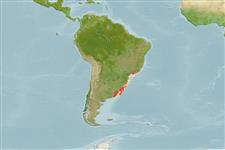>
Clupeiformes (Herrings) >
Alosidae (Shads and Sardines)
Etymology: Brevoortia: From James Carson Brevoort (1818-1887), studie the fauna from Ohio and South Caroline (Ref. 45335).
More on authors: Spix & Agassiz.
Environment: milieu / climate zone / depth range / distribution range
Écologie
marin. Subtropical; 22°S - 38°S, 60°W - 42°W (Ref. 188)
Southwest Atlantic: Rio de Janeiro, Brazil probably to mouth of Rio de la Plata, Argentina (needs confirmation).
Taille / Poids / Âge
Maturity: Lm ? range ? - ? cm
Max length : 34.4 cm TL mâle / non sexé; (Ref. 111977)
Description synthétique
Clés d'identification | Morphologie | Morphométrie
Épines dorsales (Total) : 0; Épines anales: 0. Scutes apparent along belly. Upper jaw with distinct median notch. Pectoral fin tip short of pelvic fin base by width of 3 to 7 scales; pelvic fin with oblique and almost straight hind margin. Pre-dorsal scales modified; scales on back and above base of anal fin not markedly smaller than rest. A black spot behind gill opening, but none along flank.
Forms schools (Ref. 188). The morphological characteristics observed and the composition of the trophic spectrum indicate that this species is a filter-feeder, consuming mainly phytoplankton (Ref. 34154).
Life cycle and mating behavior
Maturities | Reproduction | Spawnings | Egg(s) | Fecundities | Larves
Whitehead, P.J.P., 1985. FAO Species Catalogue. Vol. 7. Clupeoid fishes of the world (suborder Clupeoidei). An annotated and illustrated catalogue of the herrings, sardines, pilchards, sprats, shads, anchovies and wolf-herrings. FAO Fish. Synop. 125(7/1):1-303. Rome: FAO. (Ref. 188)
Statut dans la liste rouge de l'IUCN (Ref. 130435)
Menace pour l'homme
Harmless
Utilisations par l'homme
Pêcheries: commercial
Outils
Articles particuliers
Télécharger en XML
Sources Internet
Estimates based on models
Preferred temperature (Ref.
123201): 12.6 - 22.8, mean 16.8 °C (based on 104 cells).
Phylogenetic diversity index (Ref.
82804): PD
50 = 0.5156 [Uniqueness, from 0.5 = low to 2.0 = high].
Bayesian length-weight: a=0.00794 (0.00471 - 0.01341), b=3.06 (2.92 - 3.20), in cm total length, based on LWR estimates for this species & Genus-body shape (Ref.
93245).
Niveau trophique (Ref.
69278): 2.8 ±0.31 se; based on food items.
Résilience (Ref.
120179): Haut, temps minimum de doublement de population inférieur à 15 mois (Assuming tm=1).
Fishing Vulnerability (Ref.
59153): Low vulnerability (24 of 100).
Climate Vulnerability (Ref.
125649): Very high vulnerability (79 of 100).
Nutrients (Ref.
124155): Calcium = 112 [63, 192] mg/100g; Iron = 1.62 [0.89, 2.74] mg/100g; Protein = 19.5 [18.3, 20.6] %; Omega3 = 0.536 [0.326, 0.892] g/100g; Selenium = 21 [11, 42] μg/100g; VitaminA = 10.8 [3.5, 29.5] μg/100g; Zinc = 0.996 [0.692, 1.440] mg/100g (wet weight);
